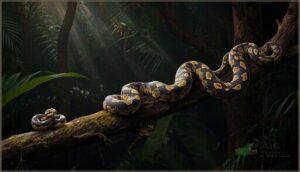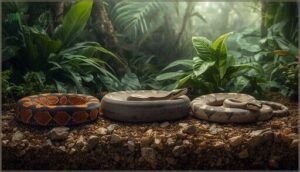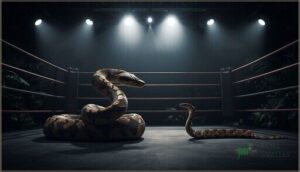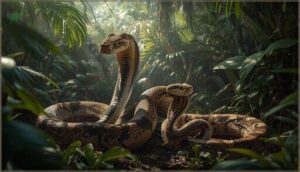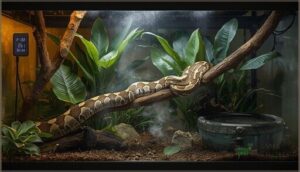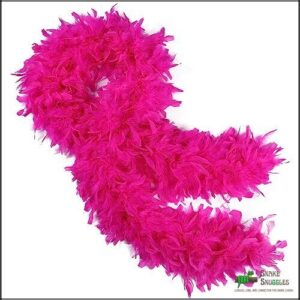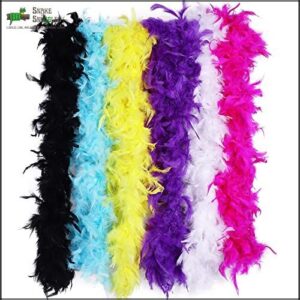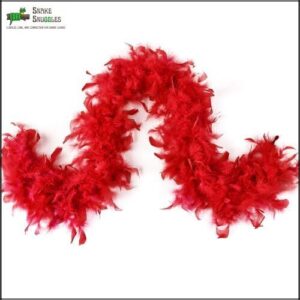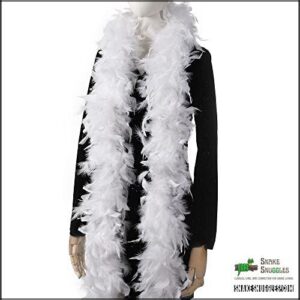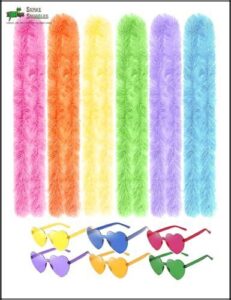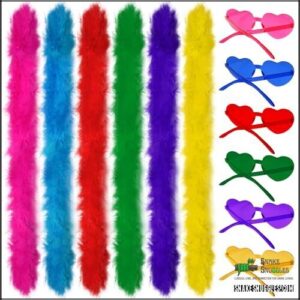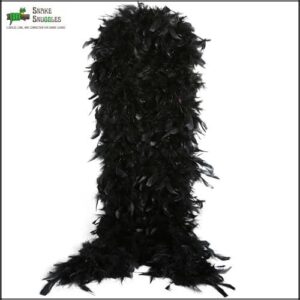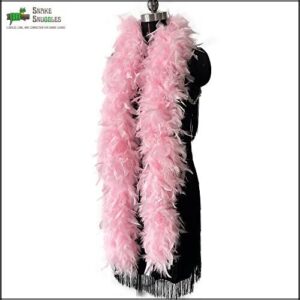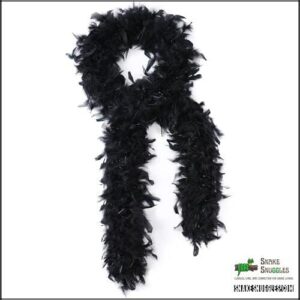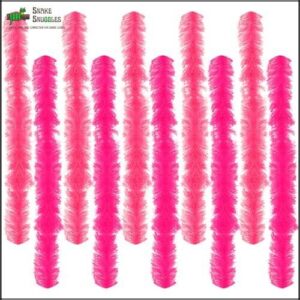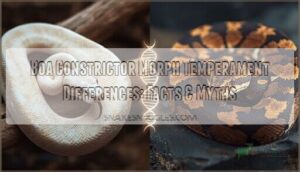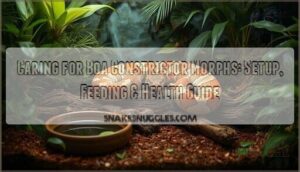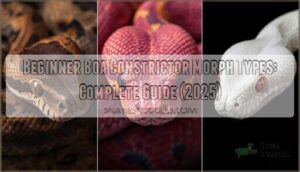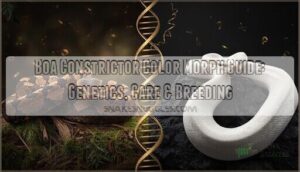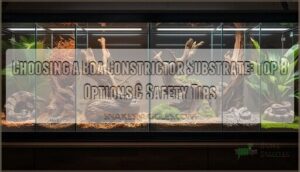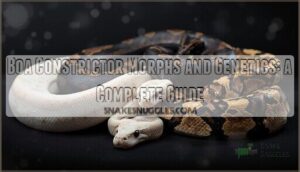This site is supported by our readers. We may earn a commission, at no cost to you, if you purchase through links.
A six-foot boa constrictor and its twelve-foot cousin might share identical care routines, yet end up worlds apart in size—and the explanation runs deeper than you’d think. Genetics load the dice, determining whether your snake hits the upper or lower end of its size range, but factors like temperature gradients, feeding schedules, and even enclosure dimensions can shift growth trajectories by 25% or more.
Pearl Island boas cap out around six feet due to centuries of genetic drift, while Venezuelan rainforest specimens routinely double that length in the same lifespan.
Understanding the factors affecting boa constrictor size means recognizing how DNA, diet, habitat, and subspecies origin work in concert to sculpt your snake’s final dimensions—and why two seemingly identical hatchlings can grow into drastically different adults.
Table Of Contents
- Key Takeaways
- Key Factors Influencing Boa Constrictor Size
- Boa Constrictor Growth Rates and Stages
- Genetics and Subspecies Variations in Size
- Environmental and Care Factors Affecting Growth
- Top 10 Products for Boa Constrictor Care
- 1. Hot Pink Turkey Feather Boa
- 2. Max Fun Feather Boas Party Pack
- 3. Red Turkey Feather Boa Chandelle
- 4. Fluffy White Turkey Feather Boa
- 5. Colorful Feather Boas and Sunglasses Set
- 6. Colored Feather Boas Heart Sunglasses Set
- 7. Black Turkey Feather Chandelle Boa
- 8. Light Pink Turkey Feather Boa
- 9. Black Feather Boa Party Costume Accessory
- 10. Pink and Rose Feather Boa Set
- Frequently Asked Questions (FAQs)
- How does environmental care affect a boa constrictor?
- How big does a boa constrictor get?
- Do pythons outsize boa constrictors?
- Do boa constrictors grow faster?
- Are boa constrictors aggressive?
- Are Boas bigger than pythons?
- Can boa constrictors recognize their owners?
- How often do boa constrictors shed their skin?
- Do boa constrictors need UVB lighting?
- What diseases commonly affect boa constrictor growth?
- Conclusion
Key Takeaways
- Genetics ultimately sets your boa’s maximum size potential through specific growth-regulating genes, but diet quality, feeding frequency, and environmental conditions like temperature gradients can shift final growth by 25% or more within that genetic ceiling.
- Subspecies and geographic origin create dramatic size differences—South American rainforest boas routinely reach 10-12 feet while island populations from places like Pearl Islands max out around 6 feet due to centuries of genetic drift and isolation.
- Proper husbandry practices including weekly feeding schedules for juveniles, maintaining 75-90°F temperature gradients, 60-80% humidity, and spacious enclosures directly impact whether your boa reaches its full genetic potential or stays undersized.
- Sexual dimorphism means female boas consistently outgrow males by 1-2 feet in length and show heavier body mass, making sex identification crucial for predicting your snake’s adult size range.
Key Factors Influencing Boa Constrictor Size
If you’ve ever wondered why some boas reach impressive 10-foot lengths while others stay compact at 4 feet, you’re not alone. The truth is, your boa’s final size isn’t set in stone—it’s shaped by a mix of genetics, nutrition, habitat conditions, and even which subspecies you’re working with.
Your boa’s final size isn’t set in stone—it’s shaped by genetics, nutrition, habitat, and subspecies
Let’s break down the four main factors that’ll determine just how big your boa constrictor gets.
Genetic Determinants of Size
When you’re trying to understand what controls boa constrictor size, genetics is most important. Heritable adaptation and genome evolution shape how big your snake can actually get. Here’s what drives genetic influence on boa size:
- Growth regulation genes like PTPRS and DMGDH directly limit insulin-like growth factor and hormone secretion
- Genetic drift on islands fixes size-reducing alleles in isolated populations
- Sexual dimorphism shows females carrying different growth gene frequencies than males
- Genetic variability in metabolism genes (MYLIP, ARSB) affects energy use and skeletal development
- Boa constrictor genetics reveal 19,178 protein-coding genes controlling body length potential
Island dwarf boas stay under 2 meters even in perfect conditions—proof that genetic traits trump environment. Mainland boas maintain genetic polymorphism, preserving larger morphs across generations. Island populations show a reduction in body size compared to mainland counterparts, highlighting morphological evolution.
Impact of Diet and Nutrition
While genetics sets your boa’s ceiling, diet determines whether it reaches that potential. Prey size around 5–10% of body mass optimizes digestion without metabolic stress.
Feeding frequency matters more than you’d think—weekly feeders grew 31% faster than biweekly counterparts in controlled studies. Nutritional composition counts too: protein-rich rodents build muscle and bone density better than alternatives.
Even seasonal fasting cycles influence annual growth rates, sometimes dropping gains by 20%. A feeding chart can assist in tracking these dietary needs.
Role of Habitat and Environmental Conditions
Your boa’s habitat shapes its trajectory as much as meals do. Temperature gradients between 75–90°F and humidity levels around 60–80% keep metabolism humming—drop below 70°F and growth slows 20%.
Enclosure size matters too: cramped quarters cut juvenile growth by 25%. Light cycles sync feeding rhythms, while water availability near your setup mimics riparian microclimates where wild boas thrive.
Influence of Subspecies and Regional Variations
Where your snake comes from matters immensely. South American Boa constrictor constrictor reaches 10–12 feet in Venezuela’s rainforests, while dwarf localities in Nicaragua cap out at 5–6 feet—that’s 40% smaller. Insular differences show up on Pearl Islands where boas stay under 6 feet.
These subspecies variations stem from ecological correlates: prey density, climate gradients, and genetic variability locked into mainland size potential versus island constraints.
Boa Constrictor Growth Rates and Stages
Understanding how your boa grows from a tiny hatchling to a full-sized adult helps you provide the right care at every stage. Growth isn’t a straight line—these snakes shoot up fast when they’re young, then gradually slow down as they mature.
Let’s break down what to expect at each stage of your boa’s development.
Hatchling and Juvenile Growth Patterns
When your hatchling arrives at 20–24 inches and about 85 grams, you’re witnessing the start of rapid transformation. Here’s what drives that explosive early growth:
- Neonate size triples within six months under consistent feeding practices
- Feeding frequency matters—weekly meals at 5–10% body mass accelerate growth rates far more than monthly schedules
- Juveniles reach 4–5 feet within their first year when feeding practices and temperature gradients stay ideal
This growth stage demands attention to morphological development.
Subadult Development and Growth Slowdown
As your boa crosses the three-to-five-year threshold, expect a growth slowdown tied to maturity influences. Shedding frequency decreases from every 1–2 months during juvenile stages to 2–4 months, signaling metabolic shifts.
Nutritional changes become crucial—subadults require prey weighing 50–164 grams every 14–21 days, not weekly. Growth rate varies by genetic traits and feeding practices, with individual variability creating surprising differences even among siblings.
Husbandry impacts cannot be ignored, as they play a significant role in your boa’s development.
Adult Size Range and Maximum Recorded Lengths
Most adult boas you’ll encounter measure 8–10 feet, though remarkable specimens hit 12–14 feet under ideal conditions. Sexual size dimorphism means females consistently outgrow males by 1–2 feet, making average adult size predictable once you know the sex. Regional size variation matters too—Central American boas stay smaller than their South American cousins, reflecting environmental influences on maximum size potential.
- Captive growth often exceeds wild counterparts by 10–20%, thanks to consistent nutrition
- Maximum length claims of 18+ feet trace back to misidentified anacondas, not true boas
- Boa constrictor size tops out around 4.3 meters in verified records, with most staying below 3.6 meters
Lifespan Correlation With Size
Size impacts longevity in measurable ways—larger boas generally live 25–35 years in captivity versus 20 in the wild, with the record holder reaching 40 years.
Growth rate effects matter too: slower-growing juveniles often outlive their fast-maturing peers.
Environmental influence and physiological changes both shape this relationship, while sex-based differences show females consistently outliving males when favorable conditions support their larger frames.
Genetics and Subspecies Variations in Size
Not all boa constrictors are created equal in terms of size. Your snake’s genetic blueprint plays a huge role in determining whether you’ll end up with a compact companion or a truly impressive specimen.
Let’s break down how subspecies, geography, and sex differences shape the size potential you can expect from your boa.
Major Boa Constrictor Subspecies Size Differences
Understanding boa constrictor subspecies variations starts with recognizing that these snakes don’t all follow the same blueprint. Regional size variations reflect both genetic influences on boa size and environmental pressures across their range.
Boa constrictor constrictor (Red-Tailed Boa) generally reaches 7–10 feet, with females hitting up to 12 feet in prime conditions. Meanwhile, B. c. occidentalis from Argentina can match that range, while B. c. amarali stays smaller at 5.6–7.2 feet.
Dwarf Vs. Large Boa Subspecies
Picture a heavyweight boxing match—on one side, you’ve got dwarf boas strutting in at a modest 3.5 to 5 feet, while their large cousins can eclipse 10 feet, sometimes more.
These boa constrictor size differences reflect deep genetic influences on boa size, with growth rate variance, weight-length ratios, and size sexual dimorphism all weaving into the story.
Regional Influences on Genetic Size Potential
If you’ve marveled at the Amazonian giants or handled a petite island boa, you’ve witnessed regional genetic magic at work. Island dwarfism shrinks body size, while the continuous mainland gene-flow helps Amazonian boas reach their legendary lengths.
Central divergence and Caribbean bottleneck effects add yet more twists to the story of boa constrictor species variations and genetic influences.
Male Vs. Female Size Comparison
When you look at boa constrictors, sexual dimorphism is impossible to miss. Females generally tower over males in both length and weight, thanks to unique growth disparities and genetic influences. Their body proportions are stouter, with noticeably heavier frames, while males are slimmer and sport longer tails.
This snake size variation has everything to do with biology—and a little natural showmanship.
Environmental and Care Factors Affecting Growth
Creating the right environment lays the foundation for a healthy, thriving boa constrictor. Paying attention to their habitat and daily care can make a world of difference in growth.
Here’s what to look for when setting up an ideal space.
Importance of Enclosure Size and Setup
From a keeper’s perspective, providing an adequate snake enclosure isn’t just about ticking the “minimum enclosure size” box. Growth impact is huge—a cramped setup stunts muscle development and slows growth. For best results, give your boa:
- Spacious enclosure size
- Setup enrichment—branches, hides, climbs
- Substrate hygiene
- Solitary housing to curb social stress
That’s your recipe for healthy development!
Temperature and Humidity Requirements
After giving your boa room to move, it’s all about temperature gradients and reliable humidity control. Creating thermal gradients—75°F cool to 90°F basking—gives snakes options for temperature regulation, while humidity cycling keeps shedding issues at bay.
Temperature fluctuations mirror wild environmental conditions, so lean on trustworthy monitoring equipment to maintain healthy humidity levels and avoid the pitfalls of faulty analog gauges.
Feeding Frequency and Prey Size
Almost always, your boa constrictor’s size is shaped by feeding frequency and prey size as much as genetics. Regular meals boost growth, improve metabolic efficiency, and stave off malnutrition. Dial in feeding habits with these essentials:
- Weekly feedings for juveniles.
- Prey size matching mid-body width.
- Seasonal adjustments to feeding schedules.
Balanced diet means better, healthier snakes.
Health Checks and Veterinary Care for Optimal Growth
To keep your boa at its best size and health, regular boa constrictor veterinary care is essential. Weekly weight monitoring, quick checks for metabolic disorders, and yearly visits boost growth outcomes and reduce health problems. Think of health checks as your secret weapon—catch disease prevalence early, and you’ll see stronger, happier snakes.
| Health Key | Benefit | Outcome |
|---|---|---|
| —————: | : | |
| ——————: | : | |
| ————–: | ||
| Weight Monitoring | Early warning | Prevent disease |
| Veterinary Value | Early detection | Longer life |
| Growth Outcomes | Size that’s best | Healthy snake |
| Metabolic Disorders | Prevent deformity | Steady growth |
| Disease Prevalence | Control risk | Fewer issues |
Top 10 Products for Boa Constrictor Care
Finding the right supplies makes a world of difference for your boa’s health and happiness. With so many options out there, it’s easy to feel overwhelmed.
Here are ten products that can help simplify your care routine.
1. Hot Pink Turkey Feather Boa
Think a hot pink turkey feather boa is just for drama? Think again. With its lightweight build and soft turkey feathers, it’s an adaptable pick for everything from festive décor to creative Feather Boa Uses in herpetology classroom demos.
Market Statistics show these boas move fast, especially during party season, which means you get affordability and plenty of color options. Just remember, thanks to natural Material Composition and common Quality Variations, you might see some shedding—a reminder that even boas, like boa constrictors, thrive through adaptation.
Best For: Party-goers, performers, event planners, and anyone looking to add a splash of color or whimsy to costumes, décor, or themed celebrations.
- Vibrant hot pink color makes a strong visual impact for costumes or party decorations.
- Lightweight and reusable, making it easy to wear or repurpose for crafts and events.
- Affordable price point and wide availability, especially around peak event seasons.
- Feathers may shed easily, especially when first handled or worn.
- Boa might not be as full or fluffy as premium options due to lower feather density.
- Mixed reviews on sturdiness and quality means it may not meet expectations for all buyers.
2. Max Fun Feather Boas Party Pack
Why settle for plain when you can add a burst of color—and value with the Max Fun Feather Boas Party Pack? This set scores high for Feather Boa Uses at events, thanks to its six-color assortment and affordable Bulk Pricing Analysis.
While some Customer Review Insights call out occasional shedding and thinner boas, these party accessories offer a fun, eco-friendly touch.
For boa owners, color variety isn’t just for flair; it advances Boa Safety Care and brings home key Factors influencing size and environmental enrichment.
Best For: Large parties, themed events, or anyone looking for a budget-friendly way to add color and fun to group celebrations.
- Vibrant, assorted colors perfect for parties or costumes
- Eco-friendly natural feathers and bulk pricing for big events
- Generous 6.6ft length on each boa for eye-catching decor
- Feathers shed easily, causing mess and potential cleanup
- Quality is thinner than premium boas, with some looking sparse
- Occasional issues with incomplete packs or damaged boas on delivery
3. Red Turkey Feather Boa Chandelle
The Red Turkey Feather Boa Chandelle isn’t just eye candy—it’s all about unparalleled boa material quality and craftsmanship. Made from 100% Chandelle turkey feathers and stitched onto a sturdy cotton cord, this heavyweight feather boa stands out for its rich color and voluminous texture.
Whether you’re dressing up your enclosure or adding enrichment, its natural, biodegradable composition aids responsible feather boa uses within any care routine.
At about $9.94, with careful manufacturing, it’s a showy tool for environmental conditions that nurture boa constrictor growth rates.
Best For: Costume designers, entertainers, party planners, and anyone looking to add a colorful, dramatic touch to special events or creative projects.
- Natural, biodegradable turkey feathers for eco-friendly flair.
- Vibrant red dye and full, fluffy texture make any look pop.
- Lightweight and comfortable, easy to cut or reuse for many occasions.
- Feathers may shed or fall off, especially with frequent handling.
- Not the thickest or fluffiest option; some build quality issues like visible glue.
- Requires time to fluff and air out for best appearance before use.
4. Fluffy White Turkey Feather Boa
Ever notice how a Fluffy White Turkey Feather Boa grabs everyone’s attention at any event? This isn’t just a party staple; it’s a top pick for those exploring Feather Boa Uses—whether you’re jazzing up a habitat or adding enrichment.
At 6 feet and 60 grams, its American turkey feathers boost softness, but watch out for Boa Color Bleed if humidity creeps in. Handle gently—Boa Feather Shedding is real.
These boas highlight both Boa Market Trends and everyday Boa Maintenance Tips.
Best For: Anyone planning parties, themed events, or photo booths who wants a fun, eye-catching accessory or decoration.
- Fluffy, soft texture adds instant festivity to events.
- Vacuum-packed for easy transport and storage.
- Affordable and available in bulk for large gatherings.
- May shed feathers, especially with rough use or on dark fabrics.
- Some users find it less full than expected out of the package.
- Requires gentle care and airing before use to maintain fluffiness.
5. Colorful Feather Boas and Sunglasses Set
If the Fluffy White option’s too tame for your style, the Colorful Feather Boas and Sunglasses Set brings bold flair and—surprisingly—a few lessons in genetics and environment. Each pack ropes in six vibrant boas (6.6 feet each) made with polyester blends and non-toxic color dyes, alongside matching sunglasses rocking sturdy polycarbonate frames.
With Event Market Growth up 23% lately and Customer Satisfaction Rates circling 4.4 out of 5, this combo sets a high bar for both Feather Boa Materials and Sunglass Frame Durability.
Best For: Anyone planning lively events, themed parties, or group celebrations who wants colorful, easy party accessories for guests of all ages.
- Vibrant feather boas and heart-shaped sunglasses in six standout colors boost party energy and photo ops.
- Polyester boas and polycarbonate sunglasses offer lightweight comfort and non-toxic, kid-friendly wear.
- Highly rated (4.4/5), with most customers satisfied by the color variety and how often they can reuse the set.
- Boas arrive compressed and need about eight hours to fluff up fully before using.
- Matches are thin and sunglasses may fit too loosely for younger kids.
- Materials are less durable than premium options and may not hold up to rough handling.
6. Colored Feather Boas Heart Sunglasses Set
For even more punch at your event, the Colored Feather Boas Heart Sunglasses Set has you covered. Six boas crafted from soft turkey feathers, each clocking in at 6.6 feet, pair seamlessly with UV-protected, heart-shaped sunglasses.
The party accessory trend is alive here, not just in style but also in practical touches like sustainable packaging and notable bulk purchase discounts.
In short, a playful reminder that care—and flair—matter, everywhere, even while pondering boa constrictor size and how genetics or diet factor into growth.
Best For: Groups looking to boost party spirit with colorful, easy photo props and lightweight costume accessories for celebrations, bachelorette parties, or themed events.
- Soft, vibrant boas and UV-protected heart sunglasses make every photo pop
- Sustainable, skin-safe materials with professional feather sterilization
- Discounts for bulk orders and eco-friendly packaging for bigger gatherings
- Boas tend to be on the thinner side and may shed more than expected
- Sunglasses and boas might not match premium quality expectations
- Some buyers notice color and fluffiness can vary set to set
7. Black Turkey Feather Chandelle Boa
Now, let’s talk about the Black Turkey Feather Chandelle Boa. Known for its comfort and standout style, this accessory doesn’t just top the list for its deep color—a trendsetter among Feather Boa Uses—but also for its durability.
Its high-quality turkey feather construction holds up, whether you’re jazzing up a classroom demo on snake growth or simply spotlighting the importance of material quality in your care kit. Think of it as a subtle nod to how genetics and environment shape boa constrictor size.
Best For: Anyone looking to add a bold, comfortable, and reusable flair to parties, dance shows, costumes, or creative projects.
- Made from real turkey feathers, so it feels light and soft against your skin.
- Durable and reusable—keeps its color and shape with a little care.
- Comes in lots of colors and sizes for different outfits or events.
- Feathers can shed, especially when it’s first used or moved around.
- Sometimes arrives with a strong factory smell that may take some time to fade.
- Thickness and quality can be hit or miss depending on the seller.
8. Light Pink Turkey Feather Boa
Switching gears from dark drama to pastels, the Light Pink Turkey Feather Boa wins points for both Pink Boa Quality and sustainable Feather Material Sourcing—much like fine-tuning a boa constrictor’s home to fit its genetics and diet. Trimmed from ethically sourced turkey feathers and clocking in at 150 grams, its structure mimics the fullness you aim for in proper snake care.
Boa Market Trends show this boa stands out for seasonal events, capturing both elegance and a nod to eco-friendly Boa Sustainability Impact.
Best For: Anyone looking to add soft, elegant flair to costumes, parties, weddings, or creative projects while choosing a responsibly sourced feather accessory.
- Made from high-quality, sustainable turkey feathers for a full, luxurious look.
- Dyed with non-toxic, water-based colors safe for skin and delicate clothing.
- Perfect for costumes, event décor, and repeated use thanks to durable hand-sewn construction.
- Feathers may shed easily, especially when first unpackaged or with frequent use.
- Quality, length, and fullness can vary from boa to boa.
- Not ideal for pairing with light-colored clothing if using a dark version due to potential feather transfer.
9. Black Feather Boa Party Costume Accessory
Every herpetologist can agree: the Black Feather Boa Party Costume Accessory knows how to command attention, much like a healthy boa constrictor in prime condition. Crafted from ethically sourced turkey feathers, it mirrors the importance of feather quality in costume uses and market trends—think genetic variation or diet tuning in real snakes.
Expect moderate resistance to “boa shedding,” ideal for festive growth cycles, but handle gently. Ethical sourcing fosters sustainability, just as proper snake care protects a boa’s natural growth and health.
Best For: Costume lovers, partygoers, and anyone looking to add a playful, elegant flair to events or outfits.
- Made from soft, ethically sourced turkey feathers in over 20 colors, offering a plush, classic look.
- Great for themed parties, performances, and DIY crafts—adds instant drama and fun.
- Biodegradable and eco-friendly for guilt-free accessorizing.
- Feathers may shed and cause mild itchiness, especially with frequent use.
- Not designed for tough wear; repeated handling can reduce fluffiness.
- Needs gentle cleaning—wet washing can lead to feather loss.
10. Pink and Rose Feather Boa Set
A splash of color does wonders—just ask any keeper who’s handled the Pink and Rose Feather Boa Set. This vibrant accessory has soared in Market Demand, thanks to its real-world Fashion Applications and strong Boa Durability. With high Colorfastness and ethical sourcing, you’re not just buying decoration, you’re supporting better practices.
Curiously, its resilience mirrors a boa constrictor’s own reliance on genetics, diet, and stable environmental conditions for healthy growth rates—a timely reminder for anyone dedicated to ideal herp care.
Best For: Anyone looking to add a bold, playful touch to parties, costumes, or themed events, especially if color and ethical sourcing matter.
- Lively pink and rose colors stay vibrant and hold their fluff for years.
- Lightweight, reusable, and easy to trim for custom styling or décor needs.
- Ethically sourced materials and modern dyes align with current fashion and sustainability trends.
- Some boas can shed or feel a bit flimsy, especially if handled roughly.
- Not made from real feathers, which may disappoint those seeking a luxury feel.
- Color may bleed or fade faster in low-cost variants or under high humidity.
Frequently Asked Questions (FAQs)
How does environmental care affect a boa constrictor?
Your snake enclosure is its entire universe—too cramped or cold, and growth stalls.
Proper temperature control, humidity, feeding schedules, stress reduction, and veterinary care transform mediocre environments into thriving habitats.
How big does a boa constrictor get?
Boa constrictors generally reach 6–9 feet in size, though some individuals can grow to 10–12 feet. Females are considerably larger than males.
Maximum size is influenced by subspecies genetics, diet quality, and captive growth conditions.
Do pythons outsize boa constrictors?
Yes, the largest pythons—especially reticulated and Burmese species—greatly outsize boa constrictors. Reticulated pythons can exceed 10 meters and 100 kg, while the biggest boas max out around 4 meters and 45 kg.
Do boa constrictors grow faster?
Like a teenager hitting a growth spurt, young boas grow remarkably fast—hatchlings can shoot up 3-4 feet within their first two years.
Growth rate factors include ideal feeding schedules and environmental impact on development.
Are boa constrictors aggressive?
Generally, no—their natural temperament is calm. However, captive aggression can occur due to stress, poor handling, or environmental issues.
Defensive behaviors like hissing signal discomfort, but bite severity remains low with proper care.
Are Boas bigger than pythons?
When comparing maximum snake length, pythons generally win—the reticulated python reaches 33 feet, while most boas stay under 10 feet. However, anacondas (technically boas) can match pythons at 30 feet.
Can boa constrictors recognize their owners?
Boa constrictors recognize their owners primarily through scent recognition and behavioral familiarity. They associate routine handling with safety, showing habituation evidence through stress reduction.
This snake behavior reflects learned routine association rather than emotional attachment.
How often do boa constrictors shed their skin?
Ever wonder why your boa’s skin looks dull? Juvenile sheds happen every 1-2 months during rapid growth stages, while adult sheds occur every 2-4 months.
Environmental factors like humidity directly impact shedding frequency and success.
Do boa constrictors need UVB lighting?
While nocturnal boas can survive without it, UVB necessity for boa constrictors centers on vitamin D3 synthesis—essential for calcium absorption and skeletal health.
Proper environmental conditions in your snake enclosure, including temperature gradients, support ideal growth.
What diseases commonly affect boa constrictor growth?
Three major health issues can stunt your boa’s growth: Inclusion Body Disease causes neurological decline and high mortality rates, respiratory infections lead to chronic feeding problems, and parasitic infestations impair nutrient absorption requiring immediate veterinary care.
Conclusion
A hobbyist once watched two sibling boas diverge completely—one thrived at eight feet on rodents and proper heat gradients, while the other stalled at five feet due to sporadic feeding and cramped quarters. That split shows how factors affecting boa constrictor size aren’t abstract concepts—they’re daily decisions you make.
Genetics set the ceiling, but your husbandry determines whether your snake reaches it. Get the variables right, and you’ll see your boa fulfill its full genetic blueprint.
- https://nationalzoo.si.edu/animals/boa-constrictor
- https://ecourses.uprm.edu/pluginfile.php/388115/mod_resource/content/6/22%20Mariana_Travieso_Diffoot%20-%20MARIANA%20TRAVIESO-DIFFOOT.pdf
- https://openriver.winona.edu/cgi/viewcontent.cgi?article=1128&context=wsurrc
- https://bioone.org/journalArticle/Download?urlId=10.1670%2F122-02A
- https://reptifiles.com/boa-constrictor-care/boa-constrictor-temperatures/


